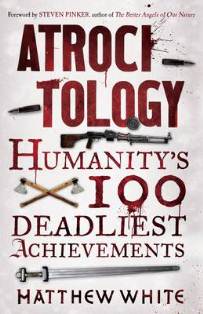
Indeed, as silly as the title sounds, this is in fact a highly intellectual and well-researched read, with a great wealth of knowledge and expertise put towards compiling this morbidly intriguing book. And author Matthew White has clearly completely immersed himself in a mind-boggling array of facts and figures in order to attempt to rank humanity’s wars and atrocities in some sort of logical order. And this in itself is one hell of a task to undertake. After all, history has a way of warping facts. And not every atrocity was recorded with any degree of accuracy. Furthermore, elaboration and exaggeration have played their equal parts in disrupting the truth in such facts and figures, as have so many other factors that make compiling such a list of this type a truly mammoth task.
White clearly has a strong background in this field. On top of this, his absolute love of statistics has proven a necessity in laboriously digging away for facts and figures on our entire race’s macabre history. A near obsessive devotion to pulling together whatever historical information there is on every war, battle, revolt or massacre, has produced a volume that throbs with a desire for factual accuracy – or as close to it as is possible.
And so, with such a vast wealth of facts and figures pulled together on this particularly macabre subject, all done for possibly the very first time (or at least so author Matthew White claims in his introduction), the book was always going to be in great danger of reading as an impersonal textbook. Indeed, with incorporating so much statistical and factual information, it’s incredibly difficult not to merely bombard the reader with too many names and numbers, making it an emotionless and altogether difficult read.
White is clearly aware of this particular problem, and quite consciously tries to avoid swamping the reader. However, the book is nevertheless still quite a difficult and unengaging read. Although White never really spends too long on any particular aspect, each chapter gradually begins to slip into a feeling of trudging repetitiveness. Important historical names come and go in the blink of an eye. Vast swathes of people are killed in an emotionless statisticians record of events. Indeed, after reading the first one-hundred pages or so, its nigh-on impossible not to feel almost completely detached from this endless stream of massacres.
Reading the book from start to finish (as I did) is possibly not the best way to read the book. White has separated the atrocities out in easily identifiable chapters and sections, which makes it easy to dip in and out of, here and there when the mood takes you. There’s really no need to read the book in any sort of order. It can become a reference book, a fact-finding aid, or merely a book that you can pick up and have a quick flick through, without needing to find where you were last.
Although crammed with facts and statistical figures, the book isn’t without a slight air of dry wit and impressionable thought. White often adds his own diagnosis about what is being detailed, with descriptions of historically accurate events being underwritten by a White’s own thoughts on the subject. Mass slaughter and genocide are put into a bigger picture, compared and contrasted against each other in a way that can seem just that little too impersonal for some.
To be honest, having almost begrudgingly trudged through the entire book, I can honestly say that I found it far from the easy and enjoyable read that it has been hailed as by many fellow reviewers. White is clearly passionate about his subject matter, but fails to engage the reader enough to alight some of that passion in them. In my opinion White fails to meet the reader halfway, and instead just pours out his laboriously researched facts, without putting in anywhere near enough effort to make these details even remotely engaging.
Chapter after chapter after chapter of names, places and numbers fly past in a sleep-inducing blur. Only in some of the latter chapters does the general interest level perk up just that little bit. However, I feel I must reiterate that this is from the point-of-view of reading the book from cover to cover. And, having done just this, I believe that this is perhaps not how the book should be read.
Other than detailing the one-hundred worst human atrocities over 530 pages, the book also contains a 6 page introduction by the author, a 1 page forward by historian Steven Pinker, 11 pages of analysis by the author, as well as a further 12 pages of raw numbers. The book finally ends with a little over one hundred pages of notes, appendices, acknowledgments, a selected bibliography and a pretty hefty index.
The book runs for a total of 669 pages.

© DLS Reviews






